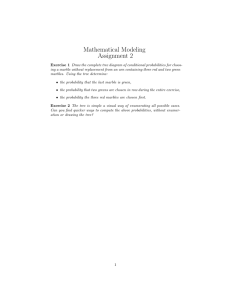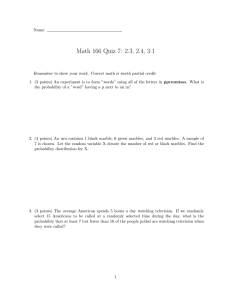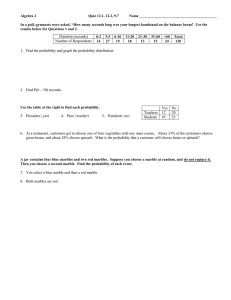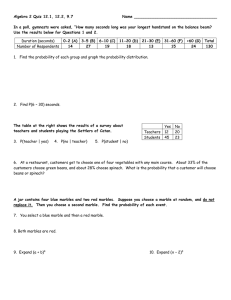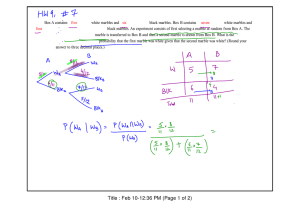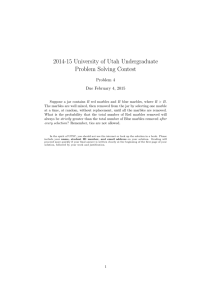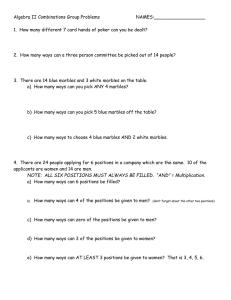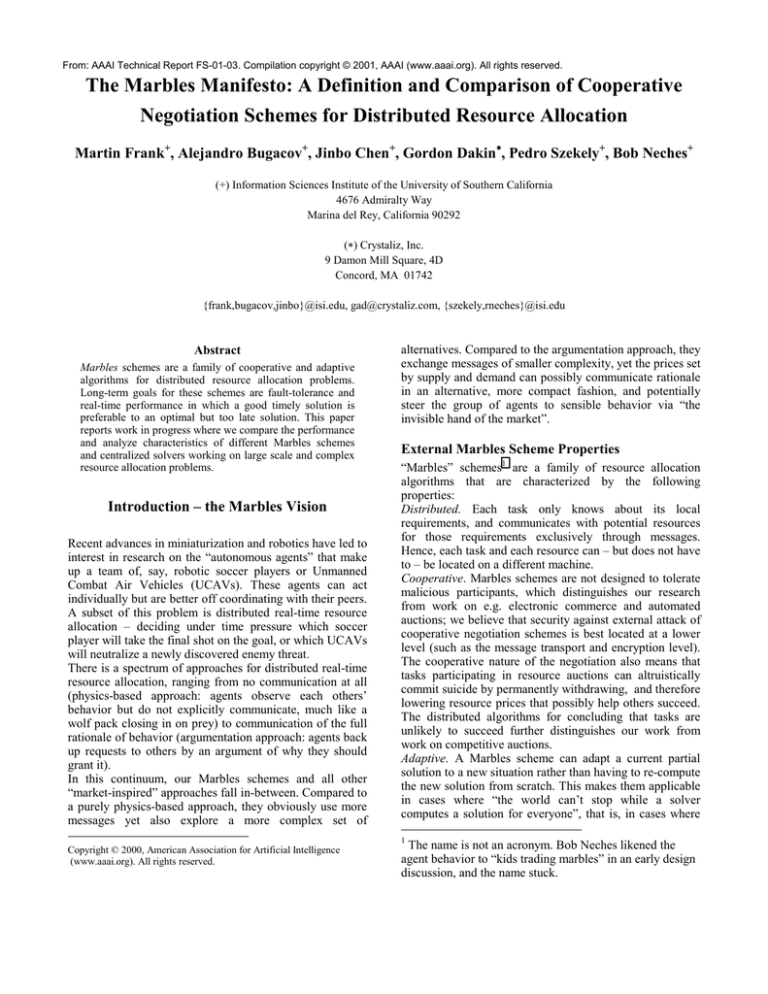
From: AAAI Technical Report FS-01-03. Compilation copyright © 2001, AAAI (www.aaai.org). All rights reserved.
The Marbles Manifesto: A Definition and Comparison of Cooperative
Negotiation Schemes for Distributed Resource Allocation
Martin Frank+, Alejandro Bugacov+, Jinbo Chen+, Gordon Dakin∗, Pedro Szekely+, Bob Neches+
(+) Information Sciences Institute of the University of Southern California
4676 Admiralty Way
Marina del Rey, California 90292
(∗) Crystaliz, Inc.
9 Damon Mill Square, 4D
Concord, MA 01742
{frank,bugacov,jinbo}@isi.edu, gad@crystaliz.com, {szekely,rneches}@isi.edu
Abstract
Marbles schemes are a family of cooperative and adaptive
algorithms for distributed resource allocation problems.
Long-term goals for these schemes are fault-tolerance and
real-time performance in which a good timely solution is
preferable to an optimal but too late solution. This paper
reports work in progress where we compare the performance
and analyze characteristics of different Marbles schemes
and centralized solvers working on large scale and complex
resource allocation problems.
Introduction – the Marbles Vision
Recent advances in miniaturization and robotics have led to
interest in research on the “autonomous agents” that make
up a team of, say, robotic soccer players or Unmanned
Combat Air Vehicles (UCAVs). These agents can act
individually but are better off coordinating with their peers.
A subset of this problem is distributed real-time resource
allocation – deciding under time pressure which soccer
player will take the final shot on the goal, or which UCAVs
will neutralize a newly discovered enemy threat.
There is a spectrum of approaches for distributed real-time
resource allocation, ranging from no communication at all
(physics-based approach: agents observe each others’
behavior but do not explicitly communicate, much like a
wolf pack closing in on prey) to communication of the full
rationale of behavior (argumentation approach: agents back
up requests to others by an argument of why they should
grant it).
In this continuum, our Marbles schemes and all other
“market-inspired” approaches fall in-between. Compared to
a purely physics-based approach, they obviously use more
messages yet also explore a more complex set of
Copyright © 2000, American Association for Artificial Intelligence
(www.aaai.org). All rights reserved.
alternatives. Compared to the argumentation approach, they
exchange messages of smaller complexity, yet the prices set
by supply and demand can possibly communicate rationale
in an alternative, more compact fashion, and potentially
steer the group of agents to sensible behavior via “the
invisible hand of the market”.
External Marbles Scheme Properties
“Marbles” schemes1 are a family of resource allocation
algorithms that are characterized by the following
properties:
Distributed. Each task only knows about its local
requirements, and communicates with potential resources
for those requirements exclusively through messages.
Hence, each task and each resource can – but does not have
to – be located on a different machine.
Cooperative. Marbles schemes are not designed to tolerate
malicious participants, which distinguishes our research
from work on e.g. electronic commerce and automated
auctions; we believe that security against external attack of
cooperative negotiation schemes is best located at a lower
level (such as the message transport and encryption level).
The cooperative nature of the negotiation also means that
tasks participating in resource auctions can altruistically
commit suicide by permanently withdrawing, and therefore
lowering resource prices that possibly help others succeed.
The distributed algorithms for concluding that tasks are
unlikely to succeed further distinguishes our work from
work on competitive auctions.
Adaptive. A Marbles scheme can adapt a current partial
solution to a new situation rather than having to re-compute
the new solution from scratch. This makes them applicable
in cases where “the world can’t stop while a solver
computes a solution for everyone”, that is, in cases where
1
The name is not an acronym. Bob Neches likened the
agent behavior to “kids trading marbles” in an early design
discussion, and the name stuck.
the time interval between situation changes is smaller than
the total running time of a non-adaptive centralized solver.
Real-Time. The individual negotiation participants should
be explicitly aware of time and adapt their behavior based
on how much time is left.
Fault-Tolerant. A Marbles scheme should be robust against
a set level of message loss, in the sense of being able to
make statements like “given an average message delay of 2
seconds and a message loss rate of 5%, this negotiation has
a 99% likelihood of concluding in less than 3 minutes”.
Obviously, no message-based scheme can ever be robust in
the sense of making a 100% real-time response guarantee if
there is a non-zero chance of a message getting lost.
Internal Marbles Scheme Properties
We further characterize Marbles scheme by their “internal”
properties; that term is accurate in the sense of being more
linked to our approach than the above “external” ones.
However, these choices do “shine through” to the user
level, so the distinction between external and internal is not
as sharp as it may sound.
Domain-based task valuation. Marbles schemes put a value
on the execution of tasks that is quantitative and that has
meaning to domain practitioners.1 The value of resources is
exclusively derived from the value of the tasks they enable;
they have no intrinsic domain value of their own.
Lack of inflation. We do not allow inflation (the artificial
introduction of currency not backed up by domain value
during negotiation) because the overall solution can
otherwise not be verified in domain terms. For example,
imagine that a negotiation scheme introduces inflation by
increasing the value of tasks the longer they go unfilled
during negotiation: consequently, the basis of the proposed
overall solution cannot be analyzed by a domain expert
without understanding the negotiation algorithm. Thus, the
problem with mixing intrinsic task value and negotiationscheme-dependent artificial “value” is that it would make
the term “domain” currency meaningless.
Ever-fluctuating prices. In the prototypical open-outcry
auction, participants bid until no one wants to bid higher,
and the highest bidder then owns the resource from that
point in time on. In contrast, Marbles schemes resources
continually auction themselves -- the auctions never
“close”. That is, you can only be the current, not final,
winner, of a resource -- if the situation changes because,
e.g., a new high-valued task appears you will lose it.
1
For example, the value of executing a training mission in
our Marine Corps application is measured in “combat
readiness percentage” (CRP) gain. For example, a pilot
may gain 0.3% CRP from participating in a mission. The
Marbles schemes themselves are unaware of the meaning
of that number - they simply see a task of domain value 300
(we multiply Marines CRP by 1000 to convert it to an
integer).
Formal Problem Statement
Below we introduce the minimalistic problem statement
that our existing Marbles schemes operate on. In the future,
we will continually expand the problem definition to, e.g.,
be able to shift tasks in time, to introduce a notion of equity
in resource use, and so on, but the current problem already
captures the essential challenge of distributed resource
allocation. Note that none of our existing Marbles schemes
presented below exhibits all of the desirable properties
outlined in the Marbles Vision section; in particular, none
of them can make real-time response or fault tolerance
guarantees yet.
Problem
There is a collection of available resources that are
characterized by a unique name (and nothing else). There is
a collection of possible tasks that are worth a fixed domain
value if they are executed. They need to acquire one
resource for each of their requirements to be executed.
Each resource can only be used for at most one task. Each
task knows in advance which resources are suitable for its
requirements. (Thus, we neglect a prior “resource
discovery” phase.)
This problem is very complex if tasks have multiple
requirements (“complementaries” exist, in economic
jargon) - it would be trivial if each task had just a single
requirement.
Solution
A solution consists of an assignment of resources to
requirements such that every task has either none or all of
its requirements filled. The quality of a solution is
measured by the sum of the domain values of its satisfied
tasks; a higher sum indicates a better solution.
Running Example
We will use the following example to explain how the
various Marble scheme variants operate. There are four
resources called A, B, C, and D. There are two tasks called
Q and R of domain value 300 and 100, respectively. Each
of the two tasks has two requirements that can be filled by
the resources indicated with a triangle below. This
particular example was chosen because it is small yet leads
to backtracking behavior if schemes assign resources to
requirements from left to right (as they usually do). The
optimal solution of domain value 400 is obvious (Q gets A
and D, R gets B and C).
A
B
Q
1
(300)
2
R
1
(100)
2
C
D
A Rough Taxonomy of Solvers
We will present a number of “solvers” – any piece of code
that produces a solution given a problem in the above
terms. Our research interest is exclusively in fully
distributed resource allocation schemes, but we have also
build a number of centralized solvers for comparison
purposes. In addition, some of our Marbles variants have so
far only addressed part of the challenge in a distributed way
because we have not had the time to make them fully
distributed.
All Marbles solvers fundamentally perform two tasks:
assigning resources to the highest-bidding tasks
(“allocation”), and eliminating tasks from competition
(“elimination”) because they drive up the prices for others
without seeming to have a chance of obtaining all of their
needed resources. Each of the variants indicates if it solves
each phase in a distributed or centralized fashion.
Marbles2 [allocation: distributed, elimination:
centralized]
The main inspiration behind this Marbles variant is that the
cost of a resource should be defined by the value that the
second-highest bidder places on it (the “displacement” or
“opportunity” cost of the resource). Consequently,
resources cost zero if no one else wants them.
Message Protocol
Task to resource: bid(amount), withdrawal(); resource to
task: loss(), win(amount that can be lower than bid),
priceChange(can be up or down but recipient is still
winning).
The Running Example under Marbles2
In this variant of our Marbles schemes, tasks attempt to fill
each requirement one at a time, bidding all of their
available value to satisfy the next unfilled requirement.
Exclamation marks indicate currently winning bidders.
1. Q simultaneously bids 300 on A, B, and D to satisfy its
first requirement. R bids 100 on A and C.
A
B
300
Q
1
300
(300)
2
R
1
100
(100)
2
C
D
300
100
2. Q obtains A for 100 (the cost as a displacement cost is
determined by the second highest bidder). It reacts by
bidding 200 for B and D (because it has internally
determined that it is better off by using A for its second
requirement 1, and has already spent 100 of its 300 value
for obtaining a resource).
1
Interestingly, we handle internal assignments by an
internal use of the very same Marbles scheme where each
Q
A
B
1
200
2
100!
R
1
100
(100)
2
C
D
200
100
3. R wins C for 0 (as there are no competing bidders). It
reacts by bidding 100 on B to obtain its second resource,
and by completely withdrawing its bid for A (it already has
a resource for its first requirement for free; otherwise it
would have bid on A whatever it had to pay for C minus the
minimum bid increment/decrement).
4. Q gets notified that the price of its A dropped to 0
(because all competition disappeared). It thus now
increases its bids for B and D to 300.
A
B
300
Q
1
(300)
2
0!
R
1
(100)
2
C
D
300
0!
100
5. Q wins B for 100 (because that’s R’s bid). It is now
satisfied, but bids 99 for D (a cheaper resource is always
preferable) just in case.
6. Q wins D for 0 because no one else wants it. It
withdraws its bid for B because nothing beats a free
resource.
7. R gets notified that it is now the winner on B (also for 0).
The scheme is in a terminal state unless the environment
changes (new high-value tasks could steal resources, for
example).
A
B
Q
1
(300)
2
0!
R
1
(100)
2
C
D
0!
0!
0!
Thus, in the end it has been determined that there is no
competition for resources at all – all tasks can be satisfied
with the available resources.
Experience and Limitations of Marbles2
As is evident from the curves in the Evaluation section, this
Marbles scheme (the first one written) tends to produce the
lowest-quality solutions and also require largest number of
messages. We believe that the latter is true because tasks
bid on all qualified resources for every requirement, and in
addition the scheme bids down prices one by one in epsilon
requirement gets the same constant value to bid on
resources won by the task, but we won’t go into the details
of that here.
In the Msmarbles (Multi-Sized Marbles) scheme each task
has the same number of marbles. The size of each marble is
the total value of the task divided by the number of marbles
that the task has. Consequently, tasks with higher value
have larger marbles.
Message Protocol
Tasks bid on resources by placing marbles on them. A task
can bid one marble at a time, and must wait for a priceupdate message from the resource before placing another
marble. Resources grant themselves to the task that has
placed the largest value (not largest number) of marbles on
them. When a task runs out of marbles, it can withdraw its
marbles from a resource. When it does so, the resource
returns all marbles to all tasks that have bid on it, with one
exception. The resource keeps one marble from the current
winner. In essence, the price for the current winner goes
down to one marble.
When a task withdraws its marbles from a resource, it will
not attempt to bid on that resource again unless it has
available at least one more marble than it got back. We call
this number of marbles the task’s “block amount” on a
given resource. Block amounts always go up, and
eventually will reach the point where a task cannot win an
allocation of resources for all its requirements because the
block amounts on the required resources exceeds the total
number of marbles that a task has. When this happens, the
task voluntarily withdraws from competition by
withdrawing all marbles from all resources. The scheme
converges because tasks keep withdrawing until all
remaining tasks succeed.
The intuition behind Msmarbles is that if the valuation of
resources emerges incrementally, in small steps, it will be
more accurate. This will enable tasks to make more
informed decisions about where to place or withdraw
marbles and when to give up, and thus lead to a better
solution.
The timing of withdrawals is critical. It is advantageous to
delay withdrawals as long as possible because by that time
other tasks may have withdrawn first and hence they
become subject to the eventually deadly block-amounts. In
order to diminish the advantages of delays, we made each
task have the same number of marbles, each task bid a
single marble at a time, and each task wait for a reply
before bidding the next marble. Richer tasks will have an
advantage, as they should, because they can delay placing
marbles. Poorer tasks may need several bids to catch up to
the bid of a richer task, hence allowing the richer task to
hold on to its marbles for a longer time.
One of the main qualities of Msmarbles is that multiple
medium-sized tasks can together bid up the valuation of
multiple resources forcing a richer task to become subject
60
Q-A
Q-B
Q-D
R-A
R-C
R-B
50
Bid Value
Msmarbles [allocation: distributed, elimination:
distributed]
to several block amounts, and eventually forcing it to give
up. This enables the Msmarbles scheme to make trade-offs
between multiple medium-sided tasks and few richer tasks.
The Running Example under Msmarbles
The first graph below shows the behavior of Msmarbles in
the simple running example. In this example we gave each
task 8 marbles (twice the number of resources). Task Q’s
marbles are worth 37.5 points, whereas Task R’s marbles
are worth 12.5 points. Lines labeled A, B, C and D
represent the valuation of resources A, B, C and D over
time. Lines Q-A, Q-B and Q-C represent the amount task Q
has bid for resources A, B and C. R-A, R-C and R-B
represent task R’s bids. Initially, both tasks bid on A. Then
they bid on the next resource they need: Q bids on B and R
bids on C. When responses come back, Q learns that it is
winning both resources. Task R learns that it is losing on A
and winning on C. Task R must now bid for B, its only
choice for requirement 2, and it keeps placing marbles on it
until it outbids task Q. When Q is outbid it determines that
the price increment to win D is 0+ (i.e., any amount larger
than 0), and hence places a marble on D. At this point, both
tasks are fulfilled and they stop bidding.
40
30
20
10
0
1
3
5
7
9
11
13
15
70
A
R-A
S-A
S-B
S-C
60
50
Bid Value
increments (rather than in logarithmic sizes as some of the
schemes below do). We have not had the time to
investigate why the former is true.
40
30
20
10
0
1
21
41
61
Time Step
81
101
Figure 1: Bid values sequence for the Msmarbles scheme
The second graph shows a more complex example where
not all tasks can be fulfilled, and tasks need to withdraw
bids and eventually withdraw from competition. The graph
shows the evolution of the price for resource A, the amount
task R bids on A (R-A), and the amounts task S bids on
resources A, B and C (S-A, S-B and S-C respectively). In
this example there are 4 tasks and 8 resources (not all
shown in the graph), and S is the poorest task with 60
points. The graph shows how S first went on a bidding war
for resource C and eventually withdrew because it needed
marbles to bid on other resources. Similarly, S had losing
bidding wars for resources A and B. A, B and C were the
only choices that S had to fulfill one of its requirements,
and after the three withdrawals, the block amounts went so
high that S would have had to use all its marbles to win one
of those resources, leaving no marbles to win resources for
its other requirements. At that point, S gave up, enabling
the other three tasks to succeed. The price for A went down
sharply enabling the task that needed it to use its marbles
for other resources. (The second problem comes from an
example that Walsh uses to demonstrate that simple
auctions cannot be used to compute optimal resource
allocations when complementarities are present. For this
particular example -- but by no means for all -- Msmarbles
computes the optimal solution).
Experience and Limitations of Msmarbles
The Msmarbles algorithm has not been as thoroughly
evaluated as the others, so that implementation bugs
disqualify it from the systematic comparison with the other
algorithms in the Evaluation section. The solutions of the
examples it does run are of high quality (defined as “close
to the best solutions of other schemes”). However, the
scheme is also one of the slowest, using significantly more
messages than the others.
Marblesize [allocation: distributed, elimination:
distributed]
The motivation of the Marblesize scheme is to allow
trading off the quality of the solution against the number of
messages needed through different pre-specified Marbles
“sizes”.
In the Marblesize scheme, no resource is free and the price
for a resource is determined by the current highest bid. To
acquire a resource, a task needs a certain number of
marbles. Marbles have given size that can be subdivided in
equal parts an arbitrary number of times. The size of the
marbles represents the minimum amount a task can bid on a
resource. For each task, the initial marble size is equal to
the task value divided by the number of requirements in
that task. At the beginning, each task selects a possible
combination of resources for its requirements and bid one
marble on each of them. After that the bidding mechanisms
continues based on the following rules: (1) If a task has
more than one possible combination of resources, it
chooses the cheapest one based on the current bids on those
resources and allocate all its value among them but placing
at least one marble on each resource. (2) A task wins if it is
winning on all of its current bids. (3) A task loses if it is
losing on all of its current bids. (4) A task that is winning
on some of its bids can move one marble at a time from a
winning resource bid to a losing resource bid. (5) A task
can cut its marble size until the marble size is less than the
minimum marble size allowed. (6) A losing task tries
another resource combination and repeats the process. If it
cannot find a new combination of resources it commit
suicide.
Message Protocol
Task to resource: bid (amount), withdrawal (); Resource to
task: loss (), win ().
The Running Example under Marblesize
First round: Q: Marble size (150) R: Marble size (50).
Q
(300)
R
(100)
A
B
150!
1
2
150!
1
50
C
D
50
2
The two requirements of task Q are winning so no changes
happen in that task. In task R both requirements are losing.
Since the first bidding proposal is no good it tries a second
bidding proposal [C,B] while keeping a marble size of 50.
Second round: Q: Marble size (150) R: Marble size (50).
Q
(300)
R
(100)
A
B
1
150!
2
150!
1
C
D
50!
50
2
Now R is winning on C that nobody wants and tries to
move its marbles from C to B.
Third round: Q: Marble size (150) R: Marble size (25).
R cuts it marble size to the minimum size of 25. Although
R is still winning on C, it cannot move its marble anymore
because each resource needs at least one minimum size
marble. So R’s second proposal is declared dead. Since it
cannot try a third proposal, R is declared dead and the
process terminates. (Thus, the scheme fails to find the
optimal solution for this simple problem -- nevertheless it
is the single best scheme we have for large problems, as
will become evident in the Evaluation section.)
Q (300)
R (100)
A
B
1
150!
2
150!
1
2
C
D
25!
75
Experience and Limitations of Marblesize
The Marblesize scheme has the unique ability to trade off
solution quality against speed of convergence. The table
below shows the impact that the minimum marble size has
on the total number of messages and the quality of the
solution. As is evident, it is possible to control the
minimum marble size to trade-off solution quality for
computational time. In this example, an increase of less that
1% of solution quality is paid by a 10 fold increase in the
number of messages.
Number of
Subdivisions
4
3
2
1
0
Total Number of
Messages
7986
6013
3635
1250
793
Maximum Value
of Solution
19017
18950
18894
18880
18649
In terms of scalability with respect to problem size, the
number of messages and solving shows a phase transition
behavior where, for fixed number of resources, the number
of messages increases sharply with the number of tasks
until it reaches a certain value where starts decreasing
again, resembling the critical behavior observed in other
combinatorial problems. We believe that this is due to the
fact that for large number of tasks the lack of resources
leads to quick suicide of most tasks with large
requirements, thus the competition quickly decreases along
the process.
Grabmarbles [allocation: distributed, elimination:
distributed]
Grabmarbles is a variation of the Marblesize scheme which
relies on heuristic selection of resource combinations. As
in Marblesize, a task bids on the cheapest set of resources
that will satisfy its requirements. Unlike the Marblesize
scheme, rebidding is not permitted after a losing resource
bid, and bids are not based on marble sizes. Instead, a task
agent submits a bid that is a heuristic evaluation of the task,
based on its domain value, number of task requirements,
and number of alternative resources. A task only bids for
resources whose prices (the evaluations of the currently
winning tasks) are less than the bidding task’s own
evaluation. When a task agent loses a bid, it gives up on
the current resource set and tries another if possible. The
heuristics used by Grabmarbles were originally applied to
Marbles2, and improvements in solution quality motivated
the application of those heuristics to Marblesize.
A heuristic task evaluation function is defined for a given
task and resource. (Note that this heuristic function actually
violates the “no inflation” rule for Marbles schemes,
making it impossible to use the prices paid for resources as
an indication for the contribution of domain value. This has
not been an issue because we have only measured pure
solution quality so far.) The following example of a task
evaluation function rewards tasks that have only one or two
alternative resources to choose from, otherwise penalizing
the task according to its number of requirements.
function taskeval (dval, reqs, alts)
if alts = 1 return dval / reqs;
else if alts = 2 return dval / (2 * reqs);
else return dval / (4 * reqs);
Message Protocol
Task to resource: bid (amount), withdrawal (); Resource to
task: loss (), win ().
The Running Example under Grabmarbles.
First round: Q selects A and B.
Q
(300)
A
B
1
37.5!
2
150!
C
D
The running example is analyzed here using the task
evaluation function described above. All resources are
initially free, so task agent Q selects A and B. Q’s domain
value of 300 and its 2 requirements yield an evaluation of
37.5 for resource A, while its evaluation with respect to A
(150) reflects the fact that A is Q’s only alternative
resource for requirement 2.
Second round: R selects B and C.
A
R
(100)
1
B
C
D
25!
50!
2
The possible resource sets available to task agent R are
(A,B) and (C,B). The cheaper alternative is (C,B), whose
total price of 37.5 is due to Q’s currently winning bid. Like
task Q, R’s second requirement has only one qualified
alternative, so R’s task evaluation with respect to resource
B comes to 50. Task Q is outbid for resource B, so it
withdraws its bids and tries another resource combination.
Third round: Q selects A and D.
Q
(300)
R
(100)
A
B
1
2
150!
1
2
C
D
37.5!
25!
50!
Task agent Q finally selects price-free resources A and D.
Both tasks are now satisfied, reaching the optimal solution
domain value of 400, with 15 messages passed.
Experience and Limitations of Grabmarbles
The Grabmarbles scheme produces solutions that are
comparable to those of Marblesize, with a relatively small
number of messages. The use of heuristics in evaluating
each task’s “deservedness” with respect to different
resources has a globally beneficial effect on resource
allocation. In the Marblesize scheme, the relative merit of
competing tasks is resolved through the process of
rebidding and transfer of funds between resources. In
Grabmarbles, the selection of resources through heuristics
tends to direct the task agents toward resources they can
realistically attain, while avoiding resources that are critical
to other tasks. The focus on globally beneficial resource
selection helps to eliminate the need for rebidding.
The choice of task evaluation formula used in
Grabmarbles has not yet been automated. The quality of
solutions is greatly affected by how well suited the
evaluation formula is for a particular problem set. The
results shown in the curves in the Evaluation section were
obtained using the following evaluation function.
function taskeval (dval, reqs, alts)
return dval / reqs – 2 * alts;
This evaluation formula fails to yield the optimal solution
domain value for the running example problem. The
previous formula emphasizes the lack of resources
available to a task, while the above formula only uses this
as a tie-breaker. A hybrid evaluation formula, combining
features of the two shown, has produced good solutions to
all of these problem sets. But there remains a need for the
automatic selection of an appropriate formula for a given
problem, based on the distribution of task requirements per
task, and alternative resources per requirement.
Brute-Force [allocation: centralized, elimination:
centralized]
We have built a trivial centralized brute-force solver that
enumerates all possible solutions and then picks the best
one. It is impractical for more than about 15 tasks and 30
resources but serves its purpose in producing small-size
challenge problems for the Marbles schemes for which the
optimal solution is known.
Random [allocation: centralized, elimination:
centralized]
Similarly, we have built a solver which synthesizes a
random solution, keeps it if it beats the previous one, and
keeps doing this until it exceeds a given time limit. We
have used it to establish lower bounds on the solution
quality for large-size problems.
Simulated Annealing [allocation: centralized,
elimination: centralized]
We have implemented a Simulated Annealing (SA) solver
[Kirkpatrick 1983] to further compare the results of the
different Marble solvers against well-known centralized
schemes. The SA algorithm seeks to escape local maximum
by accepting downhill moves with a probabilistic model
based on statistical mechanics. In our implementation of
SA we start by randomly assigning resources to tasks until
all resources are allocated. Then, for a number of maxFlips
times, we perturb or flip the state of the system to a
neighboring state by randomly picking a task, a
requirement from that task and a new resource for that
requirement from its list of eligible resources. We evaluate
δ, the change in the total value, and always accept the move
if δ ≥ 0. If δ < 0, we accept the move with probability
exp(δ/T), where T is the temperature parameter. We repeat
this procedure for different values of T, starting with a high
value of T and decreasing it following a geometric
scheduling such that Ti+1= 0.5*Ti .
Experience and Limitations of the SA implementation
In terms of performance the SA solver ranks very close to
but actually below the Marblesize solver. In certain
problem instances SA beats Marblesize in finding a higher
value in comparable execution size but on average
Marblesize beats SA. SA provides the maximum number of
flips (maxFlips) as its mechanism for externally controlling
or trading-off quality of solution for execution time, similar
to Marblesize using marble granularity for the same
purpose. Even for a surprisingly low values of maxFlips,
SA finds solutions within a few percent of the highest value
with a significant speed up in solution time. With such a
low value of maxFlips, SA is our “most efficient” solver
(as measured by dividing solution quality by running time).
SAT Encoding [allocation: centralized,
elimination: centralized]
We have also implemented a centralized SAT solver by
encoding the resource allocation problem into Boolean
satisfiability formulas in conjunctive normal form (CNF).
In this approach, the allocation of resources to tasks is
obtained by finding truth assignments to the resulting
formulas. To use satisfiability testing for optimal allocation
of resources we turn to the problem of finding valid
assignments of resources for at least k (with k ≤ N, the total
number of tasks) tasks and then do a binary search to find
the maximum k. This problem can then be encoded into a
CNF formula of the following form:
f = f ∧f
∧ f ∧ f ∧...∧ f
N
k cross 1 2
Where fk is responsible for switching on at least k of the
variables representing the N tasks, fcross precludes resources
from being assigned to more than one requirement and fi
(i=1,2,…,N) selects eligible resources within each
individual task.
SAT encoding of the running example
To encode the running example presented above for at least
two tasks (k = 2 ) filled we define the following 13 boolean
variables. First we introduce the tasks variables: t1 and t2,
that represent each task in the formula. Then we define the
resources variables A11, A12, A21, B11, B21, C21 and D11.
Where Aij=TRUE indicates the assignment of resource A to
task i requirement j. To select at least 2 different tasks
variables we introduce four additional variables p1, p2, r1, r2
with the condition that p1 -r1, p2 -r2, (p1,r1) t1 and
(p2,r2) t2. With this variables definition, the formulas
introduced above take the following form:
fk=2 =(p1∨ p2) ∧(r1∨r2) ∧(p1∨r1) ∧(p2 ∨r2) ∧(t ∨ p ∨r ) ∧
1 1 1
(t ∨ p ) ∧(t ∨r ) ∧(t ∨ p ∨r ) ∧(t ∨ p ) ∧(t ∨r )
1 1 1 1 2 2 2 2 2 2 2
fcross= (A ∨ A ) ∧(A ∨ A ) ∧(A ∨ A ) ∧(B ∨ B )
11 12 11 21 12 21 11 22
f1 = (t ∨ A11 ∨ B11 ∨ D11 ) ∧ (t ∨ A11 ∨ B11) ∧ (t ∨ A11 ∨ D11) ∧
1
1
1
28000
(t ∨ B11 ∨ D11) ∧ (t ∨ A12 )
1
1
Evaluation
We evaluated the performance of the different solvers
described above on synthetic problems that have the same
characteristics of the problems stated above but with
arbitrary number of resources and tasks. The problems
were generated by randomly assigning to each task a
certain number of requirements and a task value. The set of
possible resources for each task was also randomly selected
from the original resource pool. These random values were
independently selected from three different Gaussian
distributions. Thus, the dominant parameters in describing
a given problem are: a) number of tasks, b) number of
resources, c) r, average number of requirements per tasks,
d) v, average task value and e) p, the average number of
possible resources per requirement.
In Figure 2, we compare the performance of our solvers for
30 different problems with 100 resources and 100 tasks.
(The problems were generated with r =4, v = 300 and p =
10.) The parameters we use to evaluate performance are the
total value (i.e., the sum of the task values for all filled
tasks) of a solution and the (execution) time it took the
solver to find that solution. In the upper and lower panel of
Figure 2, we compare the results for total value and time,
respectively. We see that Marblesize, Grabmarbles and
Simulated Annealing can find comparable results of the
Total Value
We solve the resulting formula f using a Java
implementation [Jackson] of the WSAT [Selman 1993]
solver. One can verify that f evaluates to TRUE by setting
A12, B22, C21, D11, t1, t2, p1 and r2 to TRUE and all other
variables to FALSE, which yields the correct solution for
the running problem.
Experience and Limitations of the SAT Encoding
Our current SAT-based solver performs very well
compared to Marblesize and Simulated Annealing for small
and medium size problems (i.e., N ≈ 50). For larger
problems (e.g., N=100) the solution time degrades about an
order of magnitude compared to Marblesize and SA but it
is still able to produce high value results. By controlling the
number of solutions that we ask WSAT to generate, we can
externally trade-off solution quality with execution time
and the solver can sometimes find solutions within less than
5% of the best value found with SA but with 10 to 20 times
speedup. Another advantage of this approach is that it can
be used to rapidly estimate the maximum number of filled
tasks without having to search for the optimal solution.
In its current implementation the SAT-based solver is
fully centralized but the same SAT encoding approach can
be combined with Marbles or other distributed market
mechanisms [Walsh 1998] to produce a distributed solver.
24000
20000
16000
12000
8000
4000
1.E+07
1.E+06
Time (msecs)
f 2 = (t ∨ A21 ∨ C21 ) ∧ (t ∨ A21 ∨ C21 ) ∧ (t ∨ B )
2
2
2
22
Marblesize
SA
Marbles2
SAT
Grabmarbles
1.E+05
1.E+04
1.E+03
1.E+02
0
10
20
30
Figure 2: Performance evaluation of solvers on a resource
allocation problem with 100 resources and 100 tasks
total value but with Marblesize being 3 to 4 times faster
than Grabmarbles and about an order of magnitude faster
than Simulated Annealing. The results obtained with SAT
and Marbles2 are of lesser quality in terms of performance
but we see that they follow the same structure found in the
other curves suggesting that all curves are somehow
converging towards an optimal solution.
In Figure 3 we study the behavior of the total number of
messages, execution time and total value of solutions found
with Marblesize for different size of the problem. In Figure
3a, shows results for 100 tasks and different number of
resources while in Figure 3b the results correspond to 100
resources and different number of tasks. In both curves we
observe an easy-hard-easy phase-transition effect where the
number of messages (and time) increases very drastically as
the problem gets larger until it reaches a peak and after that
drops down again. This property of Marblesize is due to
the fact that unlikely to succeed tasks drop out of the
competition very early in the process and do not waste any
bidding messages. Since the distributions of task values and
number of requirements per tasks are independent, tasks
with large number of resources and low task value end up
with marbles of relatively small size that makes them lose
in all bids before entering competition. In Figure 3b, the
execution time continues to rise slowly after the transition
peak while the number of messages drops down and this is
due to the fact that in the initial phase tasks need to
evaluate alternative combination of resources before
bidding and the total computational time of this operation
increases with the number of tasks.
Related Work
What we are after are distributed negotiation schemes in
which (1) domain experts can understand the decisions
made by negotiation participants because they use a
domain currency for making their trade-offs that the experts
share, and that (2) can be “steered” in its collective realtime response, fault tolerance, and solution quality
behavior by changing their relative desirability at run-time.
45
40
Total V alue / 1000
Number of Messages/1000
35
Time (secs) * 10
coordinate between themselves (as they cannot individually
auction themselves but must bundle up with others to be
bid on in combination). We cannot say with certainty that
there may not be a space for them in real-time adaptive
distributed resource allocation but we are not currently
exploring this route.
In (c) Vickery auctions, every resource requester has an
incentive to report his true requirements to a centralized
auction mechanism which can then make an optimal
assignment of resources (solving an NP-complete problem)
and report the assignments back to the requesters. This is
obviously not an option for truly distributed resource
allocation either, and we are not investigating this avenue
further either.
This leaves (a) single-resource auctions, in which each
(b )
(a)
30
25
20
15
10
5
0
0
200
400
600
800
Num be r of Re source s
0
100
200
300
Nu m b er o f T as ks
400
500
Figure 3: Easy-hard-easy phase-transition behavior of the total number of messages and computational time for
the Marblesize scheme. (a) 100 tasks, (b) 100 resources
We list the most relevant non-market-inspired previous
work on distributed resource allocation in the References
section, but do not have the space here to discuss them at
any length (they generally address neither (1) nor (2)
above). Instead, we will use the remaining space to put the
auction protocols we use for resource acquisition in the
context of prior work.
A negotiation protocol in our terms defines the types of
messages that can be sent and how they can be strung
together (the syntax of message exchange). In our
terminology, this – together with the bidding strategies of
requesters and the auctioning strategy of requesters –
defines a “scheme” for market-based distributed resource
allocation.
Walsh et al. (1998) outline the fundamental choices in this
design space: (a) single-resource auctions, (b)
combinatorial auctions, and (c) Vickery auctions.
We view (b) combinatorial auctions as generally
inapplicable to truly distributed assignment of resources.
This is because they need a large number of messages to
resource can auction itself off to the highest-value task
based solely on its local bid information. Our Marbles
schemes are a subclass of single-resource auction.
However, the distributed algorithms introduced for the
altruistic task suicide phase distinguish our Marbles
schemes from work on competitive auctions. This task
suicide phase is fundamental for the quick convergence of
the Marbles schemes: by lowering resource prices it usually
helps other tasks succeed.
Conclusion
It is obviously far too early for us to make any claims on
how far from “optimal” in any sense our currently
implemented Marbles schemes are (be that in term of the
quality of the solution, in terms of the number of messages
needed, or any combination thereof). However we can
conclude the following:
1. Marbles-type distributed collaborative negotiation
schemes are an exciting and worthwhile research program
for years to come; this is because there are many “optimal”
solvers depending on how much the application domain
values fault-tolerance, average response time, real-time
response guarantee, and quality of the solution.
2. We are seeing “phase transitions” in our problems as is
evidenced in Figure 3; to be precise, we are seeing Gausslike curves for the amount of messages needed based on a
varying number of resources for a fixed number of tasks. A
Marbles scheme finds out quickly that few tasks can be
satisfied with the very few resources, as well as that nearly
all tasks can be satisfied with the abundant resources, but
uses substantially more computation if there are “just
enough resources for most of the tasks with the right
assignments”. However, we currently have no way of
predicting how much negotiation a given problem requires
(but are working on that in our ATTEND project).
3. It seems that the Marbles schemes with good
performance all seem to have the property of eliminating
(apparently) losing tasks very early on.
4. As this is work in progress we have not compared our
schemes against other distributed algorithms at great
length. However, based on our performance comparisons
of our best Marbles schemes to the well-known centralized
Simulating Annealing strategy we believe that this family
of market-inspired collaborative negotiation schemes is
well-suited to the real-time distributed solution of resource
allocation problems.
Acknowledgments
We gratefully acknowledge funding by DARPA ITO
ANTS program under program manager Dr. Janos
Sztipanovits (Contracts No. F30602-00-2-0533 and
F30602-99-1-0524). Part of this work was also funded by
AFOSR under grant number F49620-01-1-0341. Alejandro
Bugacov thanks Bart Selman and Carla Gomes for
assistance on the SAT encoding.
References
Andersson, M., and Sandholm, T. 1999. Time-Quality
tradeoffs in reallocative negotiation with combinatorial
contract types. In Proceedings of AAAI-99, Orlando,
Florida.
Atkins, E.; T. Abdelzaher; Shin, K.; and E. Durfee, E.
1999. Planning and resource allocation for hard realtime. In Proceedings of the Third International
Conference
on
Autonomous
Agents,
Seattle,
Washington.
Boutilier, C.; Goldzmidt, M.; and Sabata, B. 2000.
Sequential auctions for the allocation of resources with
complementarities. In Proceedings of IJCAI-99,
Stockholm, Sweden.
Choy, M., and Singh, A. 1992. Efficient fault tolerant
algorithms in distributed systems. In 24th ACM
Symposium on Theory of Computing, pp. 593–602.
Collins, J.; Sundareswara, R.; Tsvetovat, M.; Gini, M.; and
Mobasher, B. 1999. Search strategies for bid selection in
multiagent contracting. In JCAI-99 Workshop on Agentmediated Electronic Commerce (AmEC-99).
Ferguson, D.; Nikolaou, C.; Sairamesh, J.; and Yemini, Y.
1996. Economic models for allocating resources in
computer systems. In S. Clearwater (Ed.), Market-Based
Control: A Paradigm for Distributed Resource
Allocation. Hong Kong: World Scientific.
Garey, M., and Johnson, D. 1979. Computers and
Intractability: A Guide to the Theory of NPCompleteness. San Francisco, CA: W.H. Freeman and
Company.
Gent, I., and Walsh, T. 1993. Towards an Understanding of
Hill-Climbing Procedures for SAT. In Proceedings of
AAAI-93, pp. 28-33.
Jackson. We used Dr. D. Jackson’s Java implementation of
WSAT available at http://sdg.lcs.mit.edu/walksat
Kirkpatrick, S.; Gelatt, C.; and Vecchi, M. 1983.
Optimization by Simulated Annealing. Science, 220,
671-680.
Milgrom, P. 2000. Putting auction theory to work: The
simultaneous ascending auction. Journal of Political
Economy.
Sandholm, T., and Lesser, V. 1997. Issues in Automated
Negotiation and Electronic Commerce: Extending the
Contract Net Framework. Readings in Agents, pp. 66-73,
Morgan Kaufmann.
Selman, B.; Kautz, H.; and Cohen, B. 1996. Local search
strategies for satisfiability testing. AAAI-92, DIMACS
Series in Discrete Mathematics and Theoretical
Computer Science, American Mathematical Society,
26:521-532.
Smith, R. 1980. The Contract Net Protocol: High-Level
Communication and Control in a Distributed Problem
Solver. IEEE Transactions on Computers 29(12):11041113.
Waldspurger, C., and Weihl, W. 1994. Lottery scheduling:
Flexible proportional-share resource management. In
Proceedings of the First Symposium on Operating
Systems Design and Implementation, pp. 1–11.
Walsh, W.; Wellman, M.; Wurman, P.; and MacKieMason, J. 1998. Auction protocols for decentralized
scheduling. In Eighteenth International Conference on
Distributed Computing Systems, Amsterdam, The
Netherlands.
Walsh, W.; Wellman, M. 1998. Market SAT: An extremely
decentralized (but really slow) algorithm for
prepositional satisfiability. In Seventh National
Conference inartificial Intelligence, 303-309, 2000.
Wellman, M. 1996. The economic approach to artificial
intelligence. ACM Computing Surveys 28 (4es):14–15.

